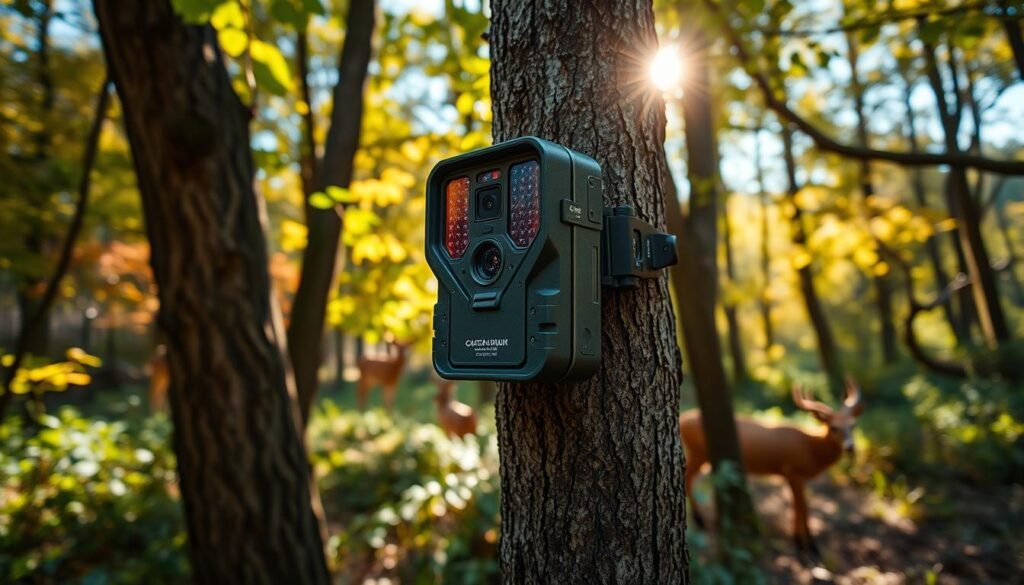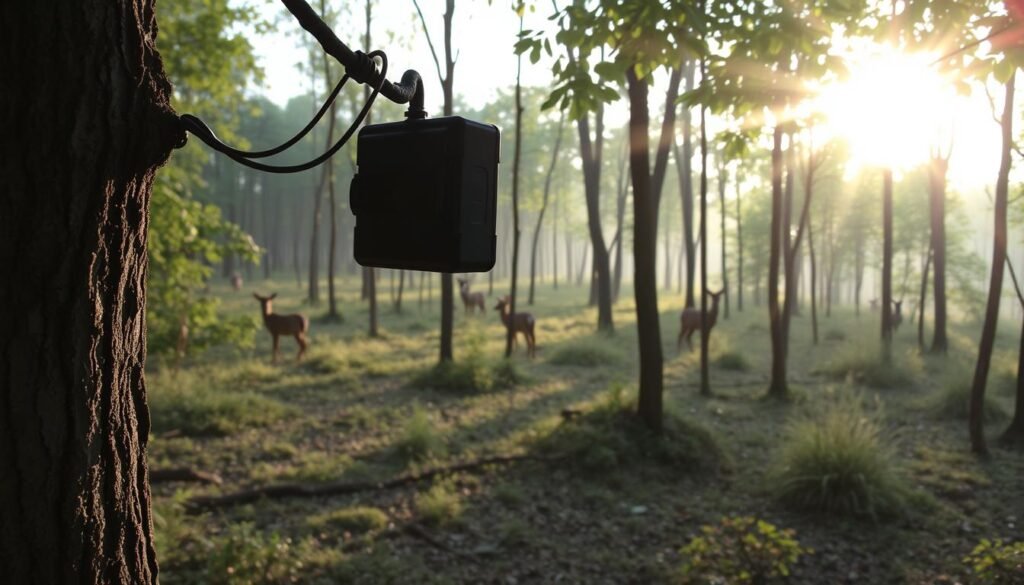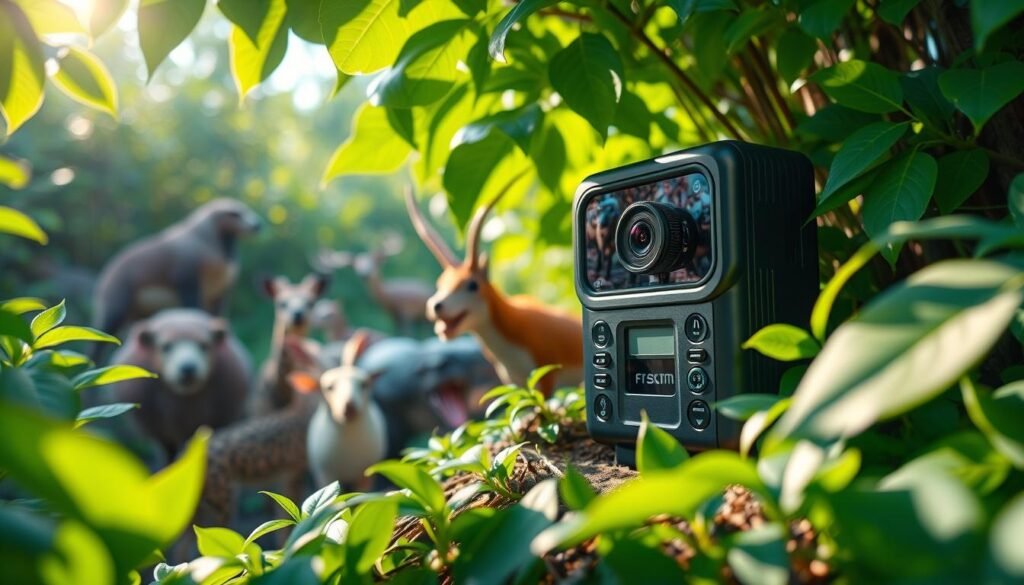Best Wildlife Camera 2025: Top Trail Cams Revealed
January 16, 2025Discover the best wildlife camera options for 2025 with our expert guide. Compare top-rated trail cameras for superior image quality, durability, and motion detection
I love watching wildlife in its natural home. Trail cameras changed how we see nature. They let us watch animals without disturbing them.
These cameras have come a long way. Now, they take amazing pictures and videos. They even send photos to your phone. This is great for hunters, scientists, and anyone who loves nature.

In this guide, we’ll look at the best wildlife cameras for 2025. We’ll talk about their cool features and how they help us see nature better. Get ready to see the latest tech that lets us capture nature’s beauty.
Understanding Wildlife Trail Cameras
Wildlife trail cameras are great for watching animals from far away. They are small and tough. They take pictures and videos when animals move in front of them.
These cameras let us see animals in their homes. It’s like having a secret way to watch them.
How Trail Cameras Work
Trail cameras are set up where animals like to go. When an animal walks by, the camera takes pictures or videos. It uses infrared flash for clear pictures at night.
Types of Wildlife Cameras
- Standard Trail Cameras: These basic models excel at capturing still images and short video clips of passing wildlife.
- Cellular Trail Cameras: Equipped with cellular connectivity, these advanced cameras can transmit captured images and videos directly to your smartphone or computer, enabling real-time remote monitoring.
- DSLR Trail Cameras: Utilizing professional-grade digital cameras, these models offer exceptional image resolution and quality, making them a popular choice for nature photography enthusiasts.
Key Features Overview
When picking a wildlife trail camera, look at a few things. Check the image quality, how far it can see, how fast it takes pictures, how long it lasts, and how much it can store. Better pictures mean more detail.
Fast cameras catch quick moments. Long battery life and storage mean it can keep watching for a long time.

Top Wildlife Camera Models for 2025
Finding the right camera is key for amazing wildlife shots. For 2025, some trail cameras are leading the pack. They have cool features and take great pictures.
The Tactacam Reveal X-Pro 3.0 is the best wildlife camera. It has a 32MP sensor and can take pictures fast. It also sees well at night.
The SpyPoint Flex G-36 is great and won’t break the bank. It has a 36MP sensor and can send pictures to your phone. It’s easy to use and works well.
The Stealth Cam Deceptor Max is perfect for night shots. It takes clear pictures in the dark. You can adjust the flash for better results.
The Moultrie Mobile Edge is the best for using your phone. It lets you control your camera from afar. You can see pictures and even watch live video.
The Stealth Cam Revolver 360 is great for seeing everything around you. It has a lens that turns to capture 360 degrees. You won’t miss a thing.
The Reconyx Hyperfire 2 Cellular is made in America. It has GPS, can send pictures, and comes with SIM cards. It’s tough and reliable.
These cameras cost between $100 and $155. Cellular plans start at $5 a month. They offer many features for all kinds of wildlife fans.

Essential Features in Modern Trail Cameras
Trail cameras are key for wildlife photography and monitoring. They have many features for nature lovers, hunters, and researchers. Let’s look at the main features of the best trail cameras in 2025.
Image Resolution and Quality
Image quality is very important in trail cameras. The best ones have up to 30-megapixel cameras. They take clear pictures of wildlife. You can also record 4K videos to see their movements in detail.
Detection and Trigger Speed
Fast detection and trigger speed are key. The latest infrared night vision camera models can spot subjects from 110 feet away. They can start recording in just 0.2 seconds, so you don’t miss anything.
Battery Life and Power Options
Battery life is crucial for long monitoring. Modern trail cameras can last months on one set of batteries. You can choose from rechargeable lithium-ion packs or solar power. This means your scouting camera is always ready to capture wildlife moments.
By focusing on these features, you can improve your wildlife photography and monitoring. The latest trail cameras are great for both hobbyists and professionals. They offer top performance, versatility, and reliability to explore the natural world.
Best Wildlife Camera Brands and Technologies
Top camera brands lead in wildlife photography with new tech and reliable use. Tactacam, SpyPoint, Stealth Cam, Moultrie, and Bushnell are leaders. They offer special features for outdoor fans and nature photographers.
These brands have made trail camera tech better. They have features like automatic network, internal memory, and live aiming via apps. Tactacam’s Reveal is known for great images and reliability. SpyPoint’s Flex G-36 is a great mix of quality and price.
Stealth Cam’s Deceptor Max takes amazing night photos. Moultrie Mobile Edge has an easy app for setting up cameras. These brands help people capture amazing outdoor moments.
Night Vision and Flash Technologies
Trail cameras use infrared (IR) tech for great night vision. They come in no-glow and low-glow types. Your choice depends on your needs and how sneaky you want to be.
No-Glow vs. Low-Glow Options
No-glow cameras, like the Tactacam Reveal X-Pro 3.0, use invisible IR flash. They capture images and videos in dark without being seen. They’re perfect for sneaky wildlife watching, but might not see as far as low-glow ones.
Low-glow cameras have a faint red glow. They’re a bit more visible but see better in the dark. Some have special sensors and lenses for better night shots.
Infrared Technology Explained
Infrared (IR) tech in no-glow trail cameras and low-glow trail cameras catches heat. This lets them take clear images and videos in the dark. It’s a cool way to see what animals do at night.
Connectivity and Storage Solutions
Modern wildlife trail cameras now have better ways to connect and store pictures. Cameras like the Tactacam Reveal X Pro send pictures live over the internet. This means you don’t have to go to the camera site often.
These cameras need a SIM card and a data plan. But, getting your pictures anytime is super easy.
Wi-Fi trail cameras, like the Moultrie Mobile Edge, connect to your home network. This lets you see your pictures right away. It’s a big help because you don’t have to get the SD card.
Storage options have also improved. You can use SD cards or cloud storage. The GardePro A3S Trail Camera uses cloud storage. This makes it easy to see your pictures on different devices.
Companies like Bushnell and Stealth Cam offer cloud services too. They have tools to help organize and analyze your pictures. This makes using your camera even better.
Today, there are many ways to connect and store your camera’s pictures. Whether you choose cellular, Wi-Fi, or cloud, you can easily watch your wildlife adventures.
Weather Resistance and Durability Features
For capturing wildlife, you need a reliable trail camera. The best ones can handle rain, snow, and extreme temperatures. They are built tough to keep your camera safe.
Protection Against Elements
Top trail cameras have IP65 or IP66 ratings. This means they can handle water and dust. They also have sealed parts and weatherproof cables to keep moisture out.
Special lens coatings stop fogging in wet places. This keeps your photos clear and sharp, even when it’s humid.
Construction Materials
These cameras have strong plastic or metal bodies. They can take impacts and protect against UV rays. They’re made to last, even when used outdoors a lot.
Temperature Tolerance
Great trail cameras work in many temperatures. Some have heaters to keep them going in cold. Others use special tech to stay cool or warm.
Getting a weatherproof trail camera is key for good wildlife photos. They’re tough and give you great pictures, no matter the weather.
Setting Up Your Trail Camera
Setting up your trail camera should be easy. It’s important to have an interface that’s simple to use. You also need easy wildlife camera placement options and a user-friendly app for managing your photos and videos.
Most trail cameras have adjustable straps for quick attachment. Some even have pre-drilled holes for mounting brackets. To set it up, download the app, create a plan, and load batteries and storage. Then, pair the camera with the app. Many cameras have LCD screens for easy setup without a phone.
For cameras that use apps for setup, it’s just as easy. Connect your camera to the app, set your preferences, and start capturing wildlife.
The aim is to have your trail camera ready fast. This way, you can focus on documenting wildlife without hassle.
Advanced Features and Innovations
Trail cameras are getting smarter. They now have cool tech like cellular and AI. These features change how we see and interact with nature.
Cellular Connectivity
Some trail cameras, like the Spypoint LINK-DARK, send pictures and videos live. They connect to your phone or cloud. This lets you watch your camera from anywhere and get alerts when animals move.
Mobile App Integration
Mobile apps make using trail cameras easy. Apps like the SpyPoint app let you change settings and see photos. They also have tools to find and track animals, making your job easier.
AI-Powered Features
AI is making trail cameras even better. They can spot animals and understand their behavior. This means less wrong photos and more useful ones. As AI gets smarter, so will your camera.
FAQ
Q: What are the best wildlife cameras for 2025?
A: The top wildlife camera models for 2025 are the Tactacam Reveal X-Pro 3.0 (best overall). The SpyPoint Flex G-36 is the best value. The Stealth Cam Deceptor Max is great for night photos.
The Moultrie Mobile Edge has the best app. The Stealth Cam Revolver 360 is best for fields and food plots. The Reconyx Hyperfire 2 Cellular is made in America.
Q: What features should I look for in a trail camera?
A: Look for image resolution and detection range. Also, check the trigger speed, battery life, and power source. Consider connectivity options like cellular, Wi-Fi, or cloud storage.
Q: What are the differences between no-glow and low-glow trail cameras?
A: No-glow cameras use invisible infrared flash for quiet observation. Low-glow models have a faint red glow. This choice depends on your needs for stealth and image quality.
Q: How do cellular and Wi-Fi trail cameras differ?
A: Cellular cameras send images in real-time over cellular networks. They need a SIM card and data plan. Wi-Fi cameras connect to local networks for access within range. Both save you from frequent site visits.
Q: What type of weather resistance and durability features are important for trail cameras?
A: Look for weatherproof housings and sealed battery compartments. They should also have weatherproof cable connections. This ensures they can handle extreme weather. Look for IP65 or IP66 ratings for dust and water protection.
Q: What advanced features are available in modern trail cameras?
A: Modern trail cameras offer cellular connectivity for real-time images. They also have mobile app integration for remote management. Plus, AI tools for better image analysis and animal identification.

